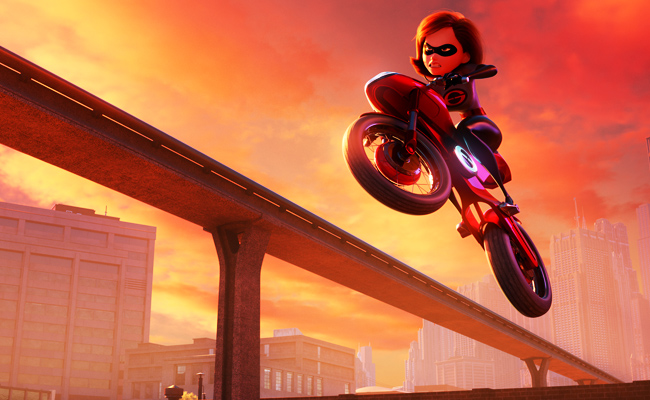
Pixar has long cultivated a mythos of being the last studio to truly put story before all else. In an era dominated by brands — Star Wars, Marvel, Harry Potter, etc. — Pixar has the singular luxury of the studio itself, and not really any specific type of story, being the “brand.” That, in addition to the natural qualities of animation, like not being driven by stars or action set pieces, have allowed them the freedom to vary their offerings widely, from dinosaurs to Dia De Los Muertos, always supposedly in service to however much they were inspired by an interesting story idea.
That perception of being story-first affords Pixar a certain “cool,” even in artsy-fartsy circles, despite being owned by Disney, the multinational’s multinational. The Incredibles 2, out this week from director Brad Bird (who also directed the original), feels like a departure from that approach — not just because it’s a sequel, and not entirely in a bad way.
Of Pixar’s first 10 films, only one was a sequel. Of their last five, The Incredibles 2 is their third. When you’re making so many sequels, it’s harder to make “telling unique stories” your calling card. The most impressive thing about The Incredibles 2 is that they seem to have found a way to compensate. Story-wise, it’s a little weak. Visually, it might be the best film they’ve ever made. Styled like a ’60s design magazine and featuring a climax set on a speeding hydrofoil (!), it manages to combine the appeal of prestige TV costume dramas and movies where The Rock has to fight a tidal wave with a helicopter. They’ve translated action movie spectacle to animation in a way that hasn’t really been done before.
Did you know the first Incredibles was set in 1962? I had no idea, and apparently, I wasn’t the only one. In the sequel, the setting is immediately apparent, opening on a fluffy-headed, turtlenecked high schooler recounting the previous day’s events to a smoky government functionary who bears a striking resemblance to a young Abe Vigoda (he has that almost-bald-but-not-quite head of greased back hair, like a later years Humphrey Bogart). We flash back to the kid hiding underneath tail-finned big blocks in the parking lot of a poodle-skirted high school during the film’s first set piece. In its first five minutes, The Incredibles 2 already has more visual identifiers than the entire original. Which is emblematic of its style-first approach, so evocative of sixties cool that you can practically smell the speaker cabinets.
The interview framing device sets up a sequence following The Incredibles — super strong dad, Elastic mom, invisible daughter, and super fast son — trying to foil “The Underminer” and his massive drill from stealing the entire town from underneath. They manage to keep the bad guy (voiced by John Ratzenberger) from hurting anyone, but he destroys half the town in the process, and The Incredibles take the blame for the damage. This sets up the major conflict, which was basically the same as the major conflict of the original — the government has outlawed superheroes. And The Incredibles, do-gooders that they are, don’t really want to defy the law. So they somehow need to change public perception without becoming outlaws.
A telecom billionaire (charmingly voiced by Bob Odenkirk) comes to their aid, promising a bold new PR strategy that will get them back in the public’s good graces, and putting them up in a Hugh Hefner-esque mansion with floating stairs and remote controllable indoor moats. It’s so swank and swingin’ sixties chic that I wanted to go home and redesign my apartment. Anyway, trouble is, the billionaire’s strategy puts Elastigirl first, leaving Mr. Incredible home with the kids — setting up the subtheme, also basically the same as the original, of Mr. Incredible feeling bored and emasculated.
The Incredibles 2 flails around for a theme, hopping from Elastigirl battling against a man’s world to having your humanity reduced by corporate logistics to a curious side story about body cameras. The conflict is a little weak and for much of the running time there’s no real villain, except maybe Mr. Incredible’s son, Dash — not because he’s evil, just thoroughly obnoxious. Though I concede that he is obnoxious in a stylishly period appropriate, Dennis The Menace kind of way.
And that’s The Incredibles 2‘s real draw: the pure style of it all. It doesn’t matter if the conflict is a little weak, because it so consistently bowls you over with stunning visuals. And it shifts effortlessly between subtle design and costume charms, like the flip of a beehive or the snap of an Earth-tone turtleneck, and massive bonkers action, like giant underground drilling machines and hydrofoil super-yachts with planes attached. In an animated film, the logistical challenges between those two types of scenes aren’t that different, and Bird’s team maintains a consistent aesthetic across both.
The Incredibles 2 isn’t exactly what Pixar has come to be known for, but it explores the possibilities of animation in ways that few big studio animated movies have. A live action film would have a hard time combining the appeal of both Mad Men and Furious 8 (Guy Ritchie’s underseen 2015 Man From U.N.C.L.E. remake is the only recent movie I can think of that comes close). With animation, as Pixar proves, it works. They may not be able to make Coco every time out, but The Incredibles 2 points to a future where that might not be so bad.






